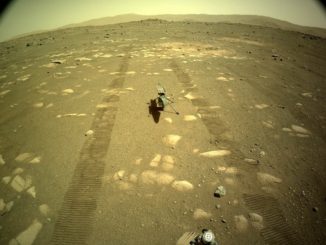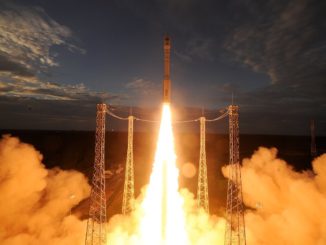
A Northrop Grumman Cygnus supply ship — named the S.S. Katherine Johnson for the trailblazing NASA mathematician portrayed in “Hidden Figures” — was loaded with time-sensitive cargo Friday at a launch pad in Virginia for a midday blastoff Saturday toward the International Space Station.
The final few items were sealed inside the Cygnus cargo freighter Friday afternoon at the Mid-Atlantic Regional Spaceport, a facility owned by the state of Virginia co-located with NASA’s Wallops Flight Facility. With the last cargo loaded, ground crews planned to close the Cygnus catch, re-install the Antares rocket’s payload shroud, and raise the launcher vertical on pad 0A at Wallops.
The final preparations overnight will also include the attachment of the Antares rocket’s liquid oxygen loading line, and the arming of pyrotechnic ordnance before the start of the five-hour countdown leading to liftoff at 12:36:50 p.m. EST (1736:50 GMT) Saturday.
The 139-foot-tall (42.5-meter) Antares rocket has a five-minute launch window to take off Saturday. Forecasters at Wallops predict a 75% chance of favorable weather for launch, and the primary weather concerns are the potential for winds and clouds to violate flight criteria.
The mission, officially designated NG-15, will be Northrop Grumman’s 15th operational resupply launch to the space station since 2014. It will be the 14th flight of an Antares rocket.
Two Russian-made RD-181 rocket engines will power the Antares launcher off the pad with 864,000 pounds of thrust. The kerosene-fueled engines will steer the rocket toward the southeast from Wallops Island, Virginia, to align with the orbital path of the space station.
At about T+plus 3 minutes, 24 seconds, the Antares will shed its liquid-fueled first stage, followed soon after by separation of the rocket’s payload fairing and interstage adapter. A solid-fueled Castor 30XL upper stage will ignite at about T+plus 4 minutes, 7 seconds, for nearly three minutes to inject the Cygnus supply ship into a preliminary orbit in pursuit of the space station. The Cygnus cargo craft is scheduled to deploy from the Antares second stage at about T+plus 8 minutes, 52 seconds.
The Cygnus will unfurl its two fan-shaped solar panels within a couple of hours after liftoff, allowing the spacecraft to start charging batteries for the day-and-a-half trip to the space station. Astronaut Soichi Noguchi aboard the research complex will use the lab’s Canadian-built robotic arm to capture the commercial resupply vessel around 4:40 a.m. EST (0940 GMT) Monday, assuming an on-time launch Saturday.

Northrop Grumman names its Cygnus supply ships after pioneers in spaceflight. The Cygnus flying on the NG-15 mission is named for Katherine Johnson, a mathematician whose trajectory calculations were critical to the success of NASA’s earliest space missions.
“It’s our tradition to name each Cygnus after an individual who’s played a pivotal role in human spaceflight, and Mrs. Johnson was selected for her hand-written calculations that helped launch the first Americans into space, as well as her accomplishments in breaking glass ceiling after glass ceiling as a Black woman,” said Frank DeMauro, vice president and general manager for tactical space at Northrop Grumman.
The NG-15 mission’s cargo load adds up to 8,399 pounds, or 3,810 kilograms, including packaging and unpressurized equipment to assist in the deployment of several CubeSats at the end of the flight. That’s more than any previous commercial cargo mission to the space station.
NASA has contracts with Northrop Grumman, SpaceX, and Sierra Nevada Corp. for resupply flights to the station. SpaceX has launched 21 operational Dragon cargo missions to date, and the record cargo payload for a Dragon capsule is 6,913 pounds, or 3,136 kilograms, on a mission launched April 2016.
Sierra Nevada’s Dream Chaser spaceplane has not flown in space yet. Its first cargo mission to the space station is scheduled for 2022.
Here is a breakdown of the cargo on the NG-15 mission:
- Vehicle Hardware: 3,115 pounds (1,413 kilograms)
- Science Investigations: 2,484 pounds (1,127 kilograms)
- Crew Supplies: 2,054 pounds (932 kilograms)
- Unpressurized Cargo: 176 pounds (67 kilograms)
- Spacewalk Equipment: 52 pounds (24 kilograms)
- Russian Hardware: 52 pounds (24 kilograms)
- Computer Resources: 2 pounds (1 kilogram)
A few minutes after releasing the Cygnus spacecraft to fly to the space station, the Antares rocket will deploy 30 tiny student-built “ThinSats” from containers on the second stage. Each ThinSat is about the size of a slice of bread, and were integrated with sensors, transmitters, and circuit boards by students ranging in age from 4th grade to college from 13 states and the District of Columbia.
The ThinSat program is a partnership between the Virginia Commercial Space Flight Authority, which runs the Mid-Atlantic Regional Spaceport, Northrop Grumman, Twiggs Space Lab, NASA’s Wallops Flight Facility, and NearSpace Labs. The program is aimed at promoting education in Science, Technology, Engineering, and Mathematics, or STEM, fields.
The first 63 ThinSats launched on an Antares rocket in 2019. By releasing the tiny satellites in a low-altitude orbit, engineers can ensure the ThinSats naturally re-enter the atmosphere and burn up within a few days, minimizing their risk of becoming space junk.
Astronauts aboard the International Space Station will enter the Cygnus spacecraft within hours of its arrival Monday. They will unpack the experiments and supplies inside the cargo craft’s pressurized compartment, built by Thales Alenia Space in Italy.
The Cygnus will deliver a brine processor assembly for the space station’s water recycling system, which converts urine into fresh drinking water. NASA says the new brine processor will demonstrate an ability to recover more water from urine brine than feasible with current space station equipment, helping close the gap to meet requirements for long-duration human exploration missions to the moon and Mars.
The brine processor works by using special membranes to separate contaminants from the brine and allow water vapor to pass into the cabin atmosphere, where a condensing heat exchanger captures and delivers it to the station system that generates fresh water.
“Long-duration crewed exploration missions require about 98% water recovery, and there is currently no state-of- the-art technology in brine processing that can help achieve this goal,” NASA officials wrote in a fact sheet. “This brine processor system plans to close this gap for the urine waste stream of the space station.”
The Cygnus mission will also carry a new sleeping quarters for the space station’s seven-person crew. There are currently five crew members on the space station’s U.S. segment, with four astronauts who flew to the outpost on SpaceX’s Crew Dragon capsule in November, and astronaut Kate Rubins, who arrived in October on a Russian Soyuz spacecraft.
But the U.S. segment only has four sleep stations. Astronaut Mike Hopkins, commander of the Crew Dragon mission, has slept inside the SpaceX capsule docked to the space station.
Other hardware inside the Cygnus supply ship includes spare parts and support equipment for the space station’s toilets, and tanks of air to recharge the breathable atmosphere inside the space lab.

One of the research experiments on the NG-15 mission will investigate how microgravity affects the manufacturing of protein-based artificial retinas. Led by a Connecticut-based startup company named LambdaVision, the experiment is a follow-up to an investigation flown to the space station in 2018 that produced “very encouraging” results, according to Nicole Wagner, president and CEO of LambdaVision.
The company uses a “layer-by-layer” process to manufacture artificial retinas, which could be implanted in patients suffering from retinal degenerative diseases.
“This is the second of what we expect to be many, many flights (to the space station),” said Jordan Greco, chief scientific officer at LambdaVision. “This particular layering trial allows allow us to continue to gather critical information on the design of the system and to continue to probe the influence of microgravity on this layering process.”
“The work that we’re sending on NG-15 is we’re sending the protein materials, and we’re actually going to manufacture the artificial retina on the ISS. So we’re doing this layer by layer process on-board the International Space Station, and then those films will then be returned back to Earth for analysis,” Wagner said.
With funding support from NASA, LambdaVision is looking at extending the layer-by-layer manufacturing process to other applications besides artificial retinas, Wagner said.
The retina implants being developed by LambdaVision can restore “high-resolution vision” to patients by replacing the function of light-sensing rods and cones inside the eye, according to Wagner. The artificial retinas consist of a light-activated protein.
“We are just thrilled to have a chance to establish a foundation for producing products in low Earth orbit with true clinical benefits to patients, and in our casem for patients that are blinded by this devastating retinal degenerative disease,” Greco said.
Another experiment on the NG-15 mission will measure muscle strength in multiple generations of worms, including animals reared in space. Humans lose strength during long-duration space missions, but scientists want to better understand the biological changes caused by microgravity.
“To understand the biology, our project is focused on taking these … worms and looking at how the strength of these worms is changing,” said Siva Vanapalli, a professor of chemical engineering at Texas Tech University, and principal investigator of the experiment.
The experiment will launch with 1,000 worm larvae that will grow during the mission. The worms will produce offspring several times in space, according to Vanapalli.
A new device, called NemaFlex, will measure the worms’ muscle forces continuously. “If we do observe that our device is able to record these changes in strength, that opens up tremendous opportunities in conducting experiments on different drugs and figuring out how to maintain and improve the health of astronauts,” Vanapalli said.
The Cygnus will deliver to the space station a high-performance commercial off-the-shelf computer from Hewlett Packard Enterprise. Engineers will test the computer’s ability to process scientific data in space, potentially enabling researchers to produce quicker results from their experiments, according to NASA.
The cargo mission also carries a radiation detector that will fly on NASA’s Orion spacecraft. A successful test of the radiation monitor on the space station would validate the unit to fly on the first crewed Orion mission, Artemis 2, to the moon in 2023, NASA said.
Email the author.
Follow Stephen Clark on Twitter: @StephenClark1.



